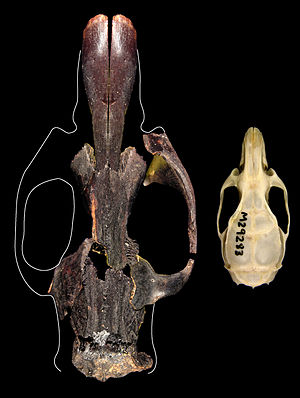Coryphomys musseri
| Coryphomys musseri | ||||||||||||
|---|---|---|---|---|---|---|---|---|---|---|---|---|

Partially preserved skull of Coryphomys musseri (left) compared to the size of the skull of a black rat ( Rattus rattus ) |
||||||||||||
| Temporal occurrence | ||||||||||||
| Late Pleistocene to Middle Holocene | ||||||||||||
| 37,000 to 5,000 years | ||||||||||||
| Locations | ||||||||||||
|
||||||||||||
| Systematics | ||||||||||||
|
||||||||||||
| Scientific name | ||||||||||||
| Coryphomys musseri | ||||||||||||
| Aplin & Helgen , 2010 |
Coryphomys musseri is an extinct species of Old World mice (Murinae) thatlivedon Timor in the Pleistocene and Holocene . Coryphomys musseri probably weighed on the order of six kilograms and was possibly a forest dweller who ate fruits and leaves. Her closest relative was Coryphomys buehleri , which is also based in Timor. Remains of the kind were in prehistoric found fireplaces from different regions Timor and 2010 by Ken Aplin and Kristofer Helgen as a new species of the genus Coryphomys described . The species is named after the American zoologist Guy Musser , who researched giant rats for decades.
features
Coryphomys musseri was, like its sister species C. buehleri , a relatively large representative of the old world mice. The dimensions of their bones correspond to those of recent species, which weigh around one to two kilograms. Typical of the genus is the combination of slightly inclined, moderately hypsodontic molar crowns , clearly formed anterocentral cuspids on molar m1, lingual main cusps t1 and t2 of the upper molars, clearly separated from the central cusps, a distinct cusp t7, which is located on molars M1 and M2 united with the cusp t8.
Taxonomy and systematics
In 2010 the remains of the giant rat were discovered in East Timor , which at six kilograms was probably the largest species of its genus. It is believed to have died out between 1,000 and 2,000 years ago, around the same time that metalworking began on Timor .
The Australian archaeologist Sue O'Connor discovered fragments of the Coryphomys musseri's teeth in the caves of Matja Kuru in Suco Tutuala, East Timor . Other remains were found there and in the Uai Bobo Cave , further west. These finds differ clearly enough from the previously known Coryphomys buehleri that they were described as a new species. The age was determined by means of radiocarbon dating .
The systematic position of Coryphomys musseri below the subfamily is unclear. Since only skull material is available for both C. musseri and C. buehleri , a phylogenetic analysis to classify the genus Coryphomys would be of limited significance. Aplin and Helgen therefore did without it in their first description of the species. The dentition of the species shows similarities to the tribe Hydromyini and Phloeomyini . Because the formation of the teeth in the Murinae depends on many different factors, can vary significantly from person to person, and similar tooth shapes have developed several times and independently of one another within the group, this is not a reliable sign of a closer relationship. The same applies to the size of the animals. Isolation of DNA from the bones of all Timorese Murinae is currently being attempted. Due to the fragmentary preservation of the genetic material, it should not allow any exact conclusions, but only a rough systematic delimitation of Coryphomys .
Web links
swell
literature
- KP Aplin, KM Helgen: Quaternary Murid Rodents of Timor Part I: New Material of Coryphomys buehleri Schaub, 1937, and Description of a Second Species of the Genus . In: Bulletin of the American Museum of Natural History . tape 341 , 2010, p. 1-80 , doi : 10.1206 / 692.1 (English).
Individual evidence
- ↑ a b ScienceDaily: Archaeologists Discover Biggest Rat That Ever Lived: Weight of About 6 Kilograms (over 13 pounds) of 26 July, 2010. , accessed on November 16, 2013
- ↑ John Norman Miksic, Geok Yian Goh, Sue O'Connor: Rethinking Cultural Resource Management in South East Asia: Preservation, Development, and neglect. 2011, ISBN 0-85728-389-8 , pp. 43-55.
- ↑ Aplin & Helgen 2010, p. 25
- ↑ Aplin & Helgen 2010, p. 26.
- ↑ Aplin & Helgen 2010, pp. 43–63.
